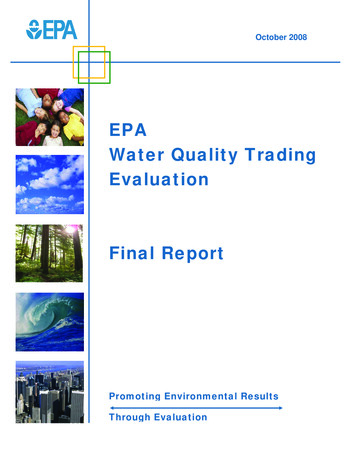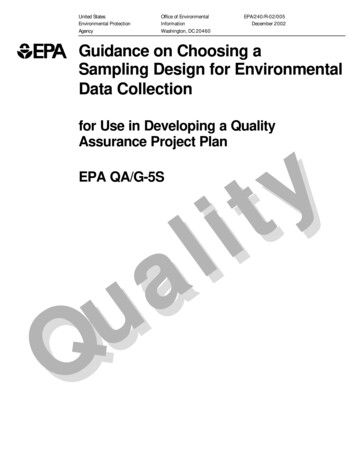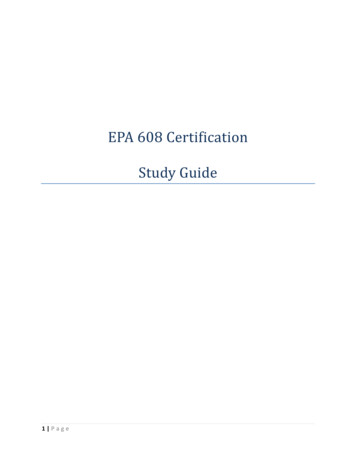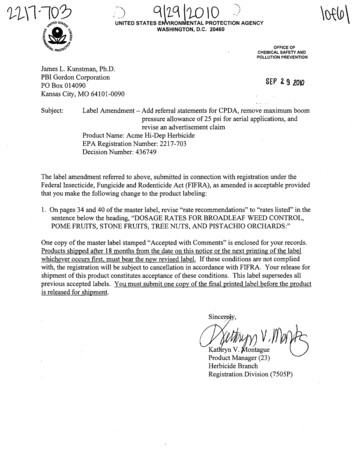
Transcription
United StatesEnvironmental ProtectionAgencyOffice ofResearch andDevelopmentOffice of Solid Wasteand EmergencyResponseEPA/540/S-97/505January 1998Ground Water IssueSteam Injection for Soil and Aquifer RemediationEva L. DavisBackgroundinformation is provided. This document is not meant to providedetailed information that would allow the design of a steaminjection remediation project, but rather design considerationsare provided to familiarize remediation workers with what isinvolved in the process.Innovative technologies for subsurface remediation, includingin situ techniques based on heating the subsurface to enhancethe recovery of organic contaminants, are increasingly beingevaluated for use at specific sites as the limitations to theconventionally-used techniques are recognized. The purposeof this Issue Paper is to provide to those involved in assessingremediation technologies for specific sites basic technicalinformation on the use of steam injection for the remediation ofsoils and aquifers that are contaminated by volatile or semivolatileorganic compounds. A related Issue Paper, entitled “How HeatCan Enhance In-Situ Soil and Aquifer Remediation: ImportantChemical Properties and Guidance on Choosing the AppropriateTechnique” (Davis, 1997), discusses the properties of someorganic chemicals commonly found at contaminated sites, howthese properties are affected by the presence of the chemical ina porous media, and how heat can enhance the recovery of thesechemicals from the subsurface. The Issue Paper also providesinformation on three general types of heat-based remediationsystems, and some guidance on which technique is mostappropriate for different soil and aquifer conditions and fordifferent organic chemicals.IntroductionSteam injection was first developed by the petroleum industryfor the enhanced recovery of oils from reservoirs. In petroleumindustry applications, steam is injected to lower the viscosity ofheavy oils and to increase the volatility of light oils. As much as50 percent of the original oil in place may remain in the reservoirwhen the process becomes uneconomical and is discontinued.In the past several years, steam injection has been adapted forthe recovery of organic contaminants from the subsurface, andextensive laboratory and field research has been done. Whensteam injection is used for subsurface remediation, the objectiveis to remove as much of the contamination as possible, thusreducing the residual to very low levels. The subsurface conditionsdealt with by the petroleum industry versus remediation purposesare generally very different - the petroleum industry dealing withdeep, confined reservoirs and the remediation industry with theshallow, generally unconfined subsurface. Thus, the petroleumindustry technique and the technique for remediation purposesdiffer in significant ways.This document contains more detailed information on howsteam injection can be used to recover organic contaminantsfrom the subsurface, the contaminant and subsurface conditionsfor which the process may be appropriate, and general designand equipment considerations. In addition, laboratory and fieldscale experiments are described, and available treatment costBasic PrinciplesConsider the situation shown in Figure 1 where steam isinjected surrounding a pool of a volatile contaminant in thesubsurface. The figure illustrates steam injection above thewater table, but steam injection for remediation purposes hasalso been successfully carried out below the water table (Newmarkand Aines, 1995), and the basic principles described here arethe same for either situation. Initially, the steam that is injectedwill heat the well bore, and the formation around the injection* U.S. Environmental Protection AgencyNational Risk Management Research LaboratorySubsurface Protection and Remediation DivisionP. O. Box 1198, Ada, OK 74820Superfund Technology Support Center forGround WaterRobert S. Kerr EnvironmentalResearch LaboratoryAda, OklahomaTechnology Innovation OfficeOffice of Solid Waste and EmergencyResponse, US EPA, Washington, DCWalter W. Kovalick, Jr., Ph.D.Director1
these processes cause the formation of a contaminant bank justdownstream of the steam front (Wu, 1977). Downstream of thisis a variable temperature zone where condensation of theinjected steam and evaporation of the contaminants takes place.The interface between the steam zone and the variabletemperature zone is essentially the location of steamcondensation, if the temperature gradient in the steam zone isnot significant. At the front of this zone is the bank of contaminantsthat have been displaced by viscous forces, followed by the hotwater bank. The zone furthest downstream is the ambienttemperature zone which is saturated with water and the mobilizedcontaminant.The amount of residual saturation remaining after the cold andhot water flush is dependent on the capillary properties of theporous media, the interfacial properties of the contaminant, andthe pressure gradient in the water causing the displacement.Residual organic liquid saturations in unconsolidated sands aretypically in the range of 14 to 30 percent (Wilson et al., 1990).The texture of the soil has been found to be the most importantfactor in determining the amount of residual organic contaminantleft in a soil. Several researchers have found that increasing thetemperature reduces the residual saturation of oils (Edmondson,1965; Poston et al., 1970; Davis and Lien, 1993).Figure 1. Diagram of a possible steam injection remediation system.The residual contaminants are volatilized by the steam, andthe volatilized contaminants are transported to the steam front,increasing the saturation of the contaminant in this zone andadding to the contaminant bank. The rate at which the contaminantbank formed by the evaporation and condensation processesmoves downstream is inversely proportional to the saturation ofthe compound downstream, and directly proportional to thevolatility of the contaminant (Yuan, 1990). Experimental workhas shown that pure, separate, liquid-phase contaminants withboiling points less than that of water will be completely removedfrom the steam zone except for the small amount which isadsorbed to solid surfaces or dissolved in liquid water which maybe present in the steam zone (Hunt et al., 1988). Theoreticalstudies have predicted that under certain conditions, liquidhydrocarbons having boiling points up to 175 C may also becompletely removed directly behind the steam condensationfront (Yuan, 1990; Falta et al., 1992b). This conclusion issupported by one-dimensional column experiments whichzone of the well. The steam condenses as the latent heat ofvaporization of water is transferred from the steam to the wellbore and the porous media where it enters the formation. Asmore steam is injected, the hot water moves into the formation,pushing the water initially in the formation (which is at ambienttemperature) further into the porous media. When the porousmedia at the point of steam injection has absorbed enough heatto reach the temperature of the injected steam, steam itselfactually enters the media, pushing the cold water and the bankof condensed steam (hot water) in front of it.As these flowing fluids approach a region that contains thevolatile contaminant at saturations greater than its residualsaturation, the contaminant is displaced. First to come intocontact with the contaminant is cold water, then the hot waterbank, and finally the steam front. The cold water will flush themobile contaminant (i.e., the contaminant saturation that is inexcess of its residual saturation) from the pores. The hot waterwill reduce the viscosity of the contaminant, making it easier tobe displaced by viscous forces, and may reduce the residualsaturation of the contaminant. When the steam front reaches thecontaminated area, no additional contaminant can be recoveredby viscous forces. Additional recovery is achieved byvolatilization, evaporation, and/or steam distillation of the volatileand semivolatile contaminants (Stewart and Udell, 1988).Thus, when steam is injected into a porous media, threedistinct zones can be considered to develop: the steam zone,the variable temperature zone, and the ambient temperaturezone. These three temperature zones are shown in Figure 2.This figure also shows the relative concentrations of thecontaminants in each of the zones. Closest to the injection pointis the steam zone which, in the area close around the injectionpoint, is at approximately the temperature of the steam. Furtherdownstream within the steam zone, the temperature maydecrease somewhat due to heat losses to the overburden andunderburden. If the rate of steam injection is sufficiently high, thepercentage of heat lost will not be great, and this zone can beconsidered essentially isothermal. In this zone, steam distillationand steam stripping are the main recovery mechanisms andFigure 2. The three temperature zones that form during a steam flood(after Wu,1977).2
showed essentially complete removal of toluene and gasoline(Hunt et al., 1988) and 96.8 to 99.8 percent recovery of No. 2 fueloil and jet fuel (Hadim et al., 1993) by steam injection.By continuing steam injection after steam breakthrough, the lessvolatile components can be recovered at greater rates as theirconcentration in the remaining liquid, and thus in the vaporphase, increases. Udell and McCarter (1996) showed in onedimensional laboratory experiments that compounds with boilingpoints up to approximately 300 C were removed by continuinginjection of steam past breakthrough while the concentrations ofcompounds with boiling points up to 450 C were reduced by atleast an order of magnitude by the injection of 100 pore volumesof steam. However, as the volume of remaining liquid decreasesand it recedes into smaller pores, interfacial effects increase andthe vapor pressure of the contaminants decreases, and thisultimately limits the amount of contaminants that can be recovered.The higher the temperature, the greater the vapor pressure(within the limits of the interfacial effects) and thus the greater therecovery (Lingineni and Dhir, 1992).Recovery MechanismsThe first recovery mechanism acting on contaminants duringa steam injection is a physical displacement, first by the wateroriginally in the subsurface, then by the hot water formed by thecondensation of steam and finally by the steam itself. Physicaldisplacement of the contaminant occurs when there is animmiscible organic liquid present at saturations greater than itsresidual saturation, and when there is a dissolved phase in thewater that is displaced with the water. A physical displacementof soil air occurs when steam is injected into the unsaturatedzone. When the initial contaminant concentration is significantlygreater than residual saturation and its volatility is low, thegreatest reduction in its saturation will be due to displacement bywater (Herbeck et al., 1976).Cycling of steam injection and vacuum extraction after steambreakthrough at the extraction well has been found to be veryeffective during field demonstrations for the recovery ofcontaminants (Udell and Stewart, 1989; Newmark and Aines,1995). Itamura and Udell (1995) have shown theoretically andnumerically that depressurizing the steam zone by halting steaminjection while continuing vapor extraction will cause athermodynamically unstable system. To bring the temperatureand pressure back into thermodynamic equilibrium, thetemperature must be reduced to the point where it is in equilibriumwith the reduced pressure of the system. Heat is lost byevaporation of the residual water and contaminants, which arethen removed from the system by vacuum extraction. Theinjection of steam after equilibrium has been reached at thelower pressure allows a recharge of the heat necessary to drivethe evaporation of contaminants, and the depressurization cyclecan then be repeated. Itamura and Udell (1995) show thatcycling of steam injection with continuous vacuum extration willalways reduce the amount of steam required to meet a givenclean-up level, and may also reduce the overall clean-up time.The increased temperatures that accompany the steaminjection process will cause decreases in the capillary andinterfacial forces between fluids and the porous media which willreduce the residual saturation of the organic phase behind thehot water front. Also, thermal expansion of the organic phasecan increase its saturation, increasing the mobile fraction anddecreasing the residual. Another effect of the increasedtemperature is a decrease in the viscosity of the organic phase,which also increases its mobility. All of these factors contributeto the formation of a bank of the organic phase in front of thesteam front that is displaced by physical forces.The main recovery mechanisms for contaminants in the steamzone are steam distillation (also called co-distillation) and steamdisplacement (stripping). Steam distillation occurs when a liquidthat is immiscible with water is present. The boiling point of themixture is reached when the total vapor pressure of the systembecomes equal to one atmosphere, rather than when the vaporpressure of the individual component becomes equal to oneatmosphere. Since both liquids contribute to the total vaporpressure, this point is reached at a lower temperature than thenormal boiling point of either of the liquids alone (Atkins, 1986).Thus, some immiscible contaminants that have a normal boilingpoint that is greater than 100 C may also be readily removed bythe steam injection process. The steam distillation process isdependent on the composition of the liquids, as well as thetemperature and pressure of the system. Steam stripping occursas the injected steam sweeps the contaminant vapor to thecondensation front, where the vapors condense, increasing thesaturation of the liquid contaminant at the condensation frontand allowing additional vaporization of the contaminant in thesteam zone. When the saturation of the contaminant exceeds itssolubility at ambient temperature, a contaminant bank is formedin front of the steam zone.Another mechanism that can enhance contaminant recoveryduring steam injection is enhanced desorption of contaminantsfrom the porous solids. For a contaminant to desorb from a solidsurface, it must absorb heat. The amount of heat that is requiredfor desorption to occur is dependent on both the contaminantand the type of soil. Lighty et al. (1988) have found thatessentially all of a semivolatile contaminant could be desorbedfrom glass beads and sands, but only about 80 percent of thecontaminant was desorbed at the same temperature from porousclays and peat. The experimental results lead to the conclusionthat a monolayer of adsorbate is strongly bound to the solidsurface of a reactive soil such as a clay. The desorption of thismonolayer is a long process (Tognotti et al., 1991), and likelyrequires temperatures significantly above the boiling point of thecontaminant for complete removal (Lighty et al., 1988). Lighty etal. (1990) found that xylene, even at temperatures above itsboiling point, can still adsorb from a gas stream onto a clayparticle. The very slow desorption indicates that a very strongbond can be formed between reactive soils and organiccontaminants.Thus, contaminants can be recovered in the vapor phase, asa separate phase liquid, and dissolved in the aqueous phase.The relative amount of the contaminants in each phase willdepend on the original concentration of the contaminant and itsboiling point. Field demonstration projects of steam injectionwhere gasoline and diesel fuel were recovered have found thatmost of the contaminant recovered was recovered in the vaporWhen the contaminant is a mixture of volatile and semivolatilecomponents, such as gasoline or kerosene, the lower boilingcomponents will vaporize first due to their larger vapor pressures.As a result of the removal of the volatile components, the liquidphase concentrations and thus the vapor pressures of theremaining “semi” and “nonvolatile” components in the liquidphase will increase, which leads to an increase in the evaporationrates of these components in the steam zone (Yuan, 1990). Thissequential vaporization of compounds means that thecontaminant bank which is recovered about the time ofbreakthrough of the steam will be enriched in the lighter, morevolatile components of the contaminant (Weyland et al., 1991).3
phase (Newmark and Aines, 1995; EPA, 1995b), while ademonstration to recover JP-5 recovered most of the contaminantas a liquid (Udell et al., 1994).semivolatile organics show very significant increases in volatilityas the temperature increases, and most have very high vaporpressures at steam temperatures.Although it has been shown that steam injection can potentiallyrecover a large percentage of volatile contaminants, it is expectedthat residual amounts of the contaminants will remain in thesubsurface. These small amounts of contaminants can likely beremediated by natural attenuation or bioremediation. Thus, it isimportant to understand the effects of steam injection on microbialpopulations and their ability to degrade residual contaminants.Biological samples were taken at the Naval Air Station Lemooreafter a steam injection demonstration to recover JP-5. Thesesamples showed high numbers of active bacteria in the zonesthat reached 80 C to 100 C for extended periods during thedemonstration and suggested enhanced biodegradation wasoccurring in the heated, oxygenated soil (Udell et al., 1994).Research carried out as part of the Dynamic UndergroundStripping project showed that before steam injection a widevariety of microorganisms were actively degrading the BTEXcomponents of gasoline. Pseudomonas was the dominantspecies originally, but Flavobacter was dominant after vacuumextraction. Above the water table, the largest populations werein areas where the contamination was at low concentrations.Below the water table, oxygen concentrations were low andthere was effectively no microbial activity. After steam injection,extensive microbial communities were found in all samples,including those where the temperature had reached 90 C. Thepopulation, however, had shifted to yeasts and related organismswhich had been observed in small numbers before heating. Thecommunity includes thermophiles previously identified fromenvironments such as hot springs, and a number of organismsapparently represent previously unidentified species. Thecommunity includes the BTEX degrader Rhodotorula (Newmarkand Aines, 1995).Stewart and Udell (1988) have shown theoretically that theviscosity of the contaminant is important in determining the sizeand saturation of the contaminant bank displaced by the steamfront. Their calculations show that steam is capable of mobilizingany length of contaminant bank up to a contaminant/waterviscosity ratio of three. For larger viscosity ratios, the displacementis unstable; i.e., fingering may occur, reducing the efficiency ofthe displacement. Their laboratory experiments support thistheory, showing that low viscosity contaminants can be recoveredin front of or just behind the steam front, while a mineral oil witha viscosity seven times that of liquid water at steam temperaturewas not recovered by steam injection.Soil type has been found to have a strong effect on the rate ofcontaminant removal from soils (de Percin, 1991; Lighty et al.,1988). Adsorption onto glass beads and silica sands does notappear to form tight bonds; the adsorption is readily reversibleeven at low temperatures. Experiments performed by Lighty etal. (1988) showed that essentially all of the xylene adsorbed bysilica sands was recovered rapidly. However, for reactivemedia, the desorption process is much slower, which may becaused by a strongly adsorbed monolayer on the particle surface(Lighty et al., 1988; Tognotti et al., 1991) or slow diffusion fromsmall inner pores to the surface of the particle (Keyes and Silcox,1994).Laboratory studies by Hadim et al. (1993) have shown thatremediation by steam injection can be achieved much morerapidly in coarser soils than in fine soils. Their experiments havealso shown that soils which are poorly sorted (i.e., have a widerrange of grain sizes) have a lower contaminant recovery efficiencywhen steam is injected. This effect is due in part to lowerpermeability in fine grained or poorly sorted soils, which causesa lower injection rate at a given injection pressure, and a greaterresidual saturation. For sands within a certain range of grainsizes, the same contaminant recoveries were achieved, but asthe grain size decreased, longer treatment times were requiredto achieve the same recovery. As the grain size was decreasedfurther, there was a reduction in the recovery efficiency.Heterogeneity in the subsurface can have a very significanteffect on the efficiency of steam injection. Small scaleheterogeneities can cause fingering, especially at the higherflow rates (Basel and Udell, 1989). Channeling will occur whenlayered heterogeneity exists due to naturally occurring beds orto manmade disturbances of the subsurface such as highlypermeable trenches containing buried utilities (EPA, 1995b).The degree of channeling that will occur increases as thedifferences in the permeabilities of the layers increases, as theratio of the layer thicknesses (more permeable layer/lesspermeable layer) increases, and as the rate of steam injectionincreases (Basel and Udell, 1991). The occurrence of channelingcan allow contaminants in the low permeability zones to bebypassed by the steam. However, there have been times whena relatively impermeable layer overlaid the target zone for steaminjection, and the impermeable “cap” limited the vertical movementof the steam (i.e., steam override), and thus increased itshorizontal spreading (Farouq Ali and Meldau, 1979; Aines et al.,1992). Thus, although lenses of less permeable soils thatcontain contaminants can reduce the efficiency of steam injection,full layers of this low-permeability medium overlying the permeablezone to be treated may actually improve the sweep efficiency ofthe injected steam through the permeable zones.Contaminant and Soil Type ConsiderationsThe decision to use steam injection for remediation should bebased on considerations of both the contaminant to be removedand the properties of the porous media to be remediated. Themost important property of the contaminant in determining itsreceptiveness to remediation by steam is its volatility. If acontaminant is not volatile, a hot water displacement without theexpense of steam injection can reduce the saturation of thecontaminant to its residual saturation. For contaminants thathave very low boiling points and a large Henry’s constant, andwhich are above the water table, vacuum extraction may be ableto adequately remove a significant portion of the contaminantfrom sandy, homogeneous soils. Steam injection is justified forremoving trapped lenses or ganglia of a volatile or semivolatilecontaminant that cannot be removed by viscous forces. Udelland Stewart (1990) feel that steam injection has perhaps thegreatest potential to significantly decrease clean-up time and,therefore, offset the greater capitol costs of the system whensemivolatile contaminants are to be removed. Semivolatilecontaminants include the less volatile petroleum hydrocarbons,such as diesel or jet fuels, and some of the higher chlorinatedsolvents. However, temperatures significantly greater thanambient temperatures may be required to desorb even volatilecontaminants, especially from clays or peat. Higher temperaturesenhance the volatilization of liquid or adsorbed contaminantsand allow greater recovery (Lingineni and Dhir, 1992). Thus,steam injection, along with vacuum extraction, may be necessaryto achieve the desired clean-up levels for volatile contaminantswhen they are present in fine soils. Most of the volatile and4
Many researchers have found that the recovery from steaminjection is related closely to heating rates (Myhill and Stegemeier,1978; Baker, 1969; EPA, 1995b). However, this dependence ismore related to steam properties and injection rates; the thermalproperties of soils and the liquid contaminants have generallynot been found to vary enough to affect the recovery achieved bysteam injection (Myhill and Stegemeier, 1978; Hadim et al.,1993). One property of the soil or aquifer to be treated that maysignificantly affect the process is the thickness of the target zone.In any steam injection process, some of the heat that is injectedwill be lost to the overlying and underlying strata. The thicker thetarget zone to be treated, the greater the percentage of theinjected heat that stays within this zone.Design ConsiderationsOne of the most important design considerations for a steaminjection process is the steam injection rate. This factor, however,cannot be separated from considerations of the injection pressure,temperature, and steam quality. The injection pressure is limitedby the depth of injection: when injection pressures greater thanthe overburden pressure are used, fracturing can occur in theoverburden, allowing steam to escape to the surface. Udell et al.(1994) recommend that the injection pressure be as high aspossible while not exceeding the soil fracture pressure which isestimated as 1.65 psi per meter of depth below the groundsurface. Thus, the shallower the zone to be treated, the lower theinjection pressure must be. There is a direct relationshipbetween the injection pressure and injection rate, which arerelated by the permeability of the media. The more permeablethe media, the greater the injection rate that can be achieved ata given limiting pressure. The greater the injection rate, thegreater the heating rate of the subsurface. Newmark and Aines(1995) recommend large amounts of steam for establishing acomplete steam zone in very permeable media. However, oncethe steam has reached the production well, the higher the steaminjection rate the more steam (and therefore heat) that is produced.Thus, once steam breakthrough has occurred, greater thermalefficiency can be achieved by reducing the steam injection rate(Myhill and Stegemeier, 1978). Newmark and Aines (1995)found that repeated steam passes were effective for heatingsmall impermeable layers in between steam zones. The optimuminjection rate is dependent on many variables specific to a givensystem, such as distance between wells, sweep efficiency, andheat losses to over- and underburden, and may be bestdetermined by field experimentation (Bursell et al., 1966).Greater heating rates generally mean greater recoveries, andgreater energy efficiency. Increasing the temperature of theinjected steam, however, does not necessarily increase the rateof heating of the target area. Johnson et al. (1971), studyingsteam displacement of oil from a reservoir, found that when theyincreased the temperature of the steam they ultimately recoveredmore oil, but the greater temperature gradient between thesteam injection zone and the over- and underburden increasedthe rate of heat loss, thus the steam front actually advanced moreslowly. Longer times were required to achieve the increasedrecovery, and the additional oil recovered at the highertemperatures required a disproportionately larger amount ofsteam. Baker (1969) found that for a given steam injection rate,the rate of heat loss to the overburden and underburden increaseswith time as the area of contact with them grows. At some point,the rate of steam input will equal the rate of loss to the over andunderburden, and the growth of the steam zone will stop. Thus,there is a maximum size to the steam zone for a given injectionrate.Several researchers have found a direct relationship betweenthe steam quality and the oil/steam ratio at the producing well.Steam quality is defined as the proportion of the total water thatis in the vapor phase; if liquid water is not present, the steamquality is 100 percent. Myhill and Stegemeier (1978) andSinghal (1980) found that as the quality of the steam at theinjection point increases, the oil/steam ratio in the extraction wellincreases.Pilot- and full-scale steam injection demonstration projectsseem to indicate that greater efficiency is achieved by usingcontinuous steam injection; i.e., 24 hours a day and at least 6Another property of the media that can affect the efficiency ofthe heating process is the permeability. When the permeabilityis low, the injection rate at a given pressure is low, whichincreases the time for heat to be lost to the overburden andunderburden, and decreases the efficiency of the overall process.Thus, sandy media are more easily treated by steam injectionthan clays. Fan and Udell (1995) studied the movement of theevaporation front during steam injection from areas of highpermeability into beds of lower permeability. They found that thelower the permeability of the less permeable zone, the higher thetemperature must be in that zone for evaporation to occur. Thereason for this is the decrease in vapor phase flux in the zonewith decreasing permeability, creating a higher pressure in thezone and thus slowing evaporation.Physical factors relating to the location and quantity of thecontaminants in the subsurface are also important. Smallvolumes of contaminated soils may be more economicallytreated by excavation and incineration, especially if thecontaminated soil is at or near the ground surface. The pressureof the injected steam is limited by the overburden pressure,which is a function of the depth of soil above the zone of injection.When the steam pressure is greater than the overburden pressure,fracturing of the overburden may occur, which could allow shortcircuiting of the steam to the ground surface. Thus, shallowcontamination may severelly limit the use of steam injection asit limits the injection pressure that can be used, again pointing
steam injection can be used to recover organic contaminants from the subsurface, the contaminant and subsurface conditions for which the process may be appropriate, and general design and equipment considerations. In addition, laboratory and field-scale experiments are described, and available treatment cost information is provided.










